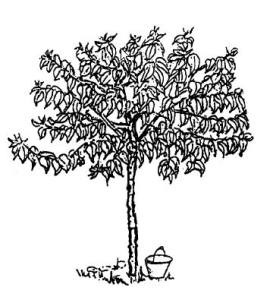Geographical Distribution of Tree tomato in Africa (red marked), source ICRAF. Updated on 27th March 2019.
Introduction
Description
 |
| Cyphomandra betacea |
| © P. Maundu and B. Tengnas, World Agroforestry Centre |
A large evergreen shrub to 3 m with characteristic umbrella-like branching
Bark: Young stems are shiny, old stems with rounded leaf scars.
Leaves: Alternate, large, rather heart-shaped, 40 x 30 m cm, softly hairy, drooping in heat, on a long stalk
Flowers: In fragrant hanging groups from older stems. Each flower is 5-lobed, white-pink and with a darker stripe.
Fruit: In clusters, egg-shaped to 7 cm long, abundant, on long stems, shiny orange-red to purple.
Propagation and Tree Management
Uses:
Edible fruit (vegetable, jam) bee forage
Propagation:
Seedings, cuttings, wildings. Use of cuttings from mother plants with good fruit ensures that a good type is propagated. Cuttings of 1 - 2-year-old wood, 10 - 30 mm thick and 45 - 100 cm long can be defoliated and planted directly in the field. Cuttings may give need to be removed to promote growth in the first year.
Seed
90,000 - 18,000 seeds per kg. Separate seed from fruit pulp, clean and dry in the shade.
Treatment:
Not required, although freezing may improve germination.
Storage:
Store well.
Fast growing. Pruning. Shallow root system, so deep cultivated should be avoided near the tree. Mulch is beneficial.
Remarks:
The fruit is slower to ripen at higher altitudes, the acid fruit can be eaten raw or cooked, the quality depending on the variety grown. Large-scale commercial production and organized marketing occurs in New Zealand, but international trade in the fruit and preserves remains small. No named cultivars exist. Red fruits are often chosen for fresh fruit markets because they look attractive, but they have a stronger, more acid flavour than yellow ones. Yellow fruit can be canned, but the juice of the red fruit is too abrasive.
Information Source Links
- Bekele-Tesemma, B. (2007). Useful trees and shrubs for Ethiopia. World Agroforestry Centre, Nairobi, Kenya. ISBN 92-9059-2125
www.worldagroforestry.org - ICRAF,Cyphomandra betacea. www.worldagroforestry.org
- Maundu, P. and Tengnäs, B. (2005). Useful trees and shrubs for Kenya. World Agroforestry Centre. ISBN: 9966-896-70-8
www.worldagroforestry.org
